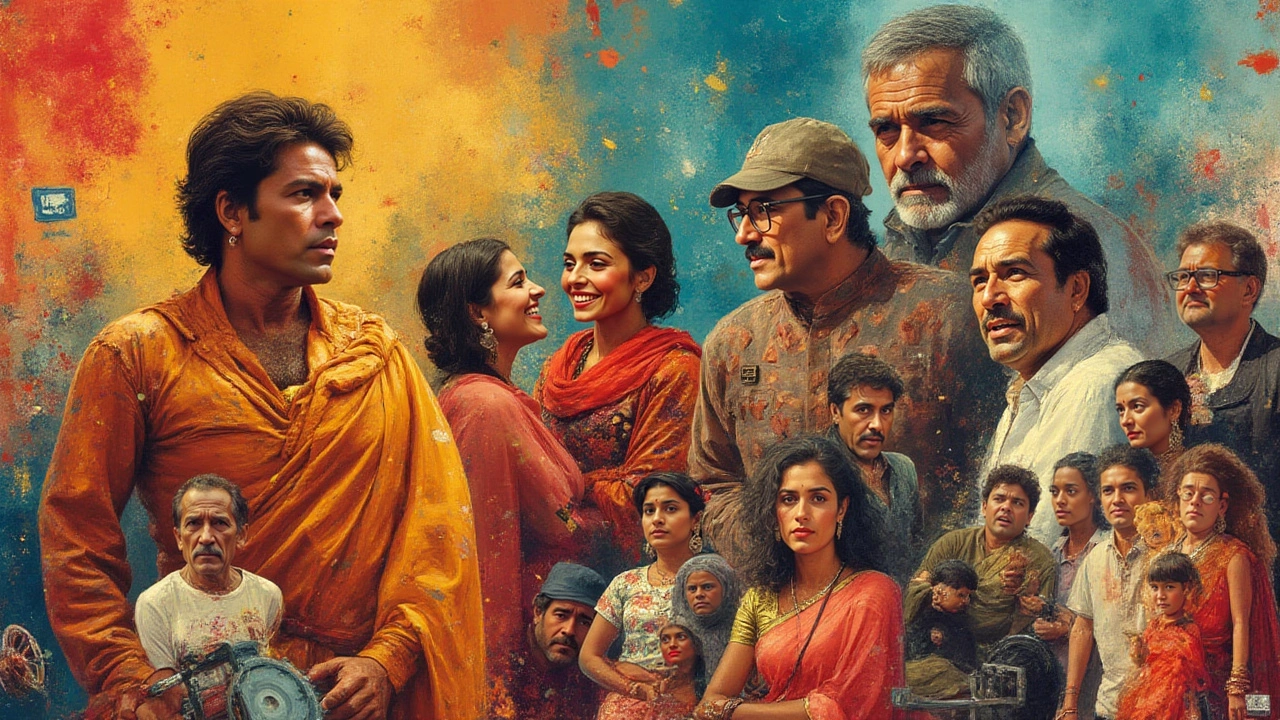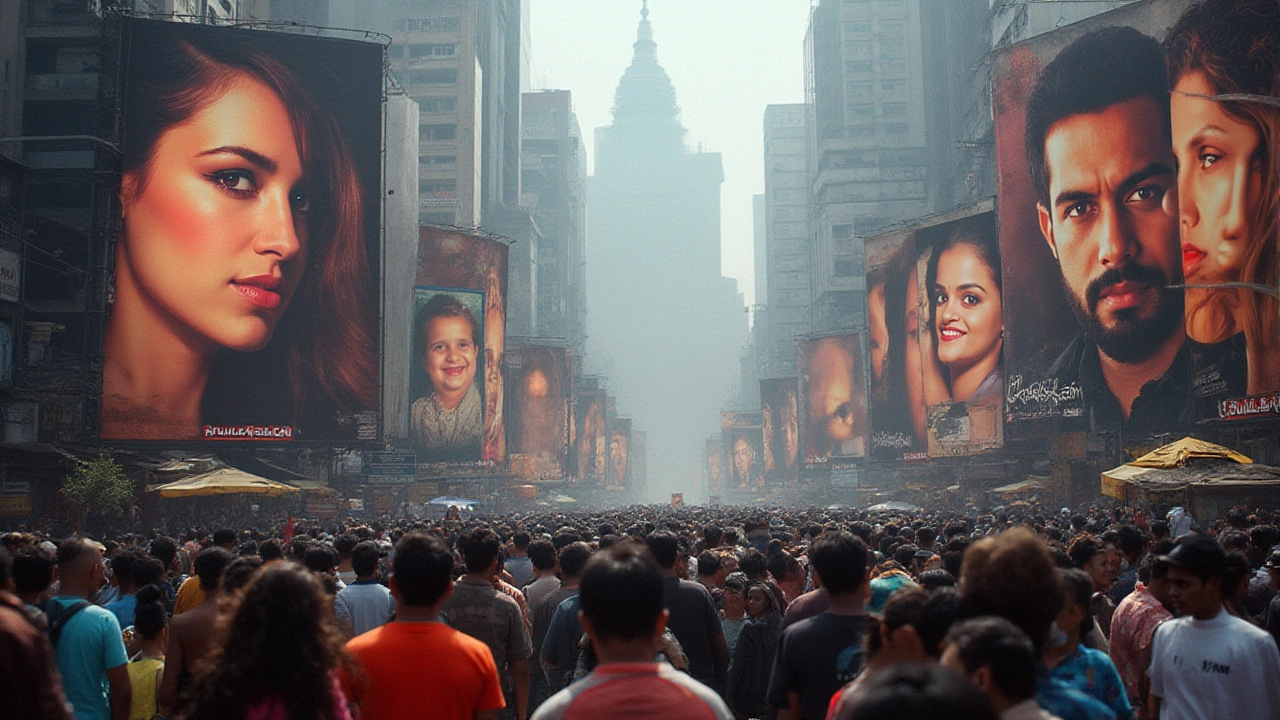Who is the Biggest Megastar in Indian Cinema? Facts, Stats, and Legends
 Jul, 5 2025
Jul, 5 2025
People always argue about the biggest name in Indian cinema. The title 'megastar' comes loaded with wild fan loyalty, endless box office stories, and more than a few internet wars. Is it about who makes the most money, who commands the wildest crowds, or simply the one who never gets forgotten? Some say it's about old-school charm, others claim it's about modern reach. But here, it's all about facts, numbers, and those moments that made your jaw drop in the darkened theater.
The Ever-Expanding Universe of Indian Cinema
Indian cinema is gigantic. It’s not just Bollywood—think beyond Mumbai: Telugu, Tamil, Kannada, Malayalam, Bengali, Marathi, and even Bhojpuri cinemas pull in crowds and churn out stars. India produces over 1,800 films a year, across more than 20 languages. The scale is bonkers. A 2024 FICCI-EY report puts the Indian film industry's annual revenue at $2.7 billion. For context, that's more than many European countries combined. While Hollywood flicks may lead at the global box office, Indian stars gather the largest home audiences anywhere. Movies here aren't just entertainment. They're almost a religion. Go to Hyderabad and watch a new Telugu release—fans perform pujas (prayer ceremonies) before the movie starts. In South India, gigantic cutouts of the lead actor fill entire streets. Up North, first day-first show tickets sell out months ahead, even for stars past their prime. Stars matter more than scripts, directors, or technical wizardry. If you see a festival-like frenzy at a cinema, bet it’s a big star’s release. In fact, a study by the Indian Statistical Institute found that 70% of box-office earnings for commercial films are driven by the 'star factor' alone. That’s wild brand power.
The Criteria: What Makes a 'Megastar'?
You can't crown someone a megastar just because they have a snazzy Instagram profile or a bunch of hit songs. You need hard metrics. First up: box office dominance. A true megastar needs a blockbuster streak—the kind of record where even unimpressive films still make money because the name alone packs theatres. Next, the size and madness of their fanbase. It’s not about a few followers, either. Social media trends, worldwide fan clubs, and people camping outside their house are part of the vibe. Then there’s cultural impact—how much does this person's image seep into everyday language, ads, memes, and even politics? The drama doesn’t end there. Awards add polish, yes, but long-term relevance matters more. Who’s still topping lists after decades? Finally, look at their global footprint. Have they broken out of India? Do NRI (non-resident Indian) crowds in New York City, London, or Sydney go nuts for them? Is their face more recognizable worldwide than some heads of state? These questions matter.
The real megastar boasts the rare blend: household fame, bankable hits, crazy loyal fans, influence over time, and the ability to set trends across boundaries. For fun, check out this quick comparison, looking at 'megastars' past and present:
| Star | Years Active | Box Office Hits | Global Reach | Social Media Followers (2025) |
|---|---|---|---|---|
| Amitabh Bachchan | 1969-present | Over 100 | Asia, Middle East, Africa | 47M (Instagram) |
| Rajinikanth | 1975-present | 60+ | South Asia, Japan | 10M (Twitter) |
| Shah Rukh Khan | 1992-present | 80+ | Worldwide | 50M (Instagram) |
| Salman Khan | 1988-present | 70+ | Asia, Gulf States | 68M (Instagram) |
| Prabhas | 2002-present | 10 | Pan-India, Global (Baahubali) | 12M (Instagram) |

Legends of the Past: Who Set the Gold Standard?
The race for megastar status didn’t start with Shah Rukh or Salman. Indian cinema’s earliest golden boys were Raj Kapoor and Dilip Kumar. In the 1950s and 60s, these men practically defined stardom—Raj Kapoor’s movies made waves everywhere from Moscow to Cairo. His film 'Awaara' topped Soviet charts for years. Dilip Kumar gave drama a face, turning tragic heroes into legends. But the 1970s wiped the slate clean. Enter Amitabh Bachchan. He changed the meaning of stardom in India—fans called him 'angry young man,' but honestly, he was more like a cultural hurricane. During the late 70s and 80s, Bachchan was producing 10-12 movies a year—sometimes even with overlapping releases on the same day! Cities erupted. Theatres played his movies non-stop for months. By the 80s, he was India’s first true pan-Indian superstar, cutting across language, class, and region. In an age before social media, his fan mail was said to rival postal deliveries for medium-sized towns. Newspapers from the 80s report fans running blood donation drives and shaving their heads for Amitabh's health scares.
Then in the South, another legend was building: Rajinikanth. His fans are on another level. They bathe his cutouts in milk. They celebrate his birthday like it's Diwali. For a while, he was the first Indian actor to hit it big in Japan—his film 'Muthu' did better than some Hollywood hits back in the 90s. Both Bachchan and Rajini set standards for what a 'megastar' truly is: not just acting chops, but a massive following and a pop culture legacy you can’t escape. No wonder their fame lingers even as new faces pop up every Friday. If you visit Mumbai or Chennai today, you’ll still see massive crowds lining up for their cameos or special appearances. That’s iconic longevity.
Modern Battles: Shah Rukh, Salman, Rajinikanth, and the New Crop
If you’re talking about 'the' biggest megastar, since the 1990s, the name that comes up everywhere—Karachi to Cape Town, Berlin to Boston—is Shah Rukh Khan. He started out with TV and tearjerker scripts, but flipped the game with his charm, sarcastic wit, and those now-famous romantic arms-wide-open poses. India’s love for SRK is nuts. He has fans not just from Gujarati villages, but also from Morocco, Germany, Russia, and even obscure French towns. He’s called the 'King of Bollywood' for a reason. The French government awarded him the Legion of Honour. Forbes India ranked him as the highest-paid Indian actor several years in a row. As of 2025, his net worth circles around $750 million, and he owns one of Mumbai’s most famous landmarks, the Mannat villa—tourists actually stop by hoping to see him wave from the balcony! SRK’s films have racked up more than $5 billion in box office revenue over his career. One insane fact: his movie 'Pathaan' (2023) crossed 1,000-crore mark worldwide, beating plenty of Hollywood blockbusters that year.
Salman Khan, though, is no pushover. More than an actor, he’s a phenomenon. His loyalist fan clubs—called the 'Salmaniacs'—hold food drives and charity marathons wherever his movies launch. In the last decade, almost every Salman release opened at over 100 crore in India, no mean feat given the competition. His style is pure mass appeal: larger-than-life action, pithy one-liners, and big attitude. His presence alone guarantees a packed theatre, sometimes even for movies critics pan. Salman’s followers also make him the most-followed Indian actor on Instagram, above everyone, with 68 million fans flicking through his latest gym photo or charity work post.
Down South, Rajinikanth refuses to slow down. Even after five decades, his movies create a frenzy that rivals anything you’ll see in Bollywood. The Tamil diaspora—Singapore, Malaysia, Sri Lanka, even Texas—throws street parties when his movie trailer drops online. In 2024, his film opened bigger than many Marvel releases across India. And let’s not forget Allu Arjun and Prabhas. The 'Baahubali' series put Prabhas on the world map, with the second film dragging in $280 million worldwide—which is bonkers for an Indian period epic. Allu Arjun’s 'Pushpa' went viral in Russia and Africa. The rise of streaming has given these new pan-India stars a passport to nearly every country. These days, a South Indian superstar can rival Bollywood numbers thanks to dubbed releases and streaming on Netflix and Amazon Prime Video.
Here's a quick list of mega facts about these living legends:
- Shah Rukh Khan owns the IPL cricket team Kolkata Knight Riders, boosting his brand even when he's off-screen.
- Rajinikanth was once a bus conductor in Bangalore before films made him larger than life.
- Salman Khan’s brand endorsements and hosting of reality TV shows like 'Bigg Boss' add millions to his income every year.
- Prabhas’ 'Baahubali' series has merchandise, theme park rides, and even a Netflix prequel series in development.

The Verdict: Who Takes the Crown Today?
So who owns the megastar throne right now? Honestly, it depends who you ask—and where you are. In North India and globally, the answer still leans toward Shah Rukh Khan. His influence stretches far: Ukrainians painting murals of him in Kyiv, Moroccans opening fan cafes, and even Harvard using his career in 'leadership and innovation' courses. One fun fact: in 2018, SRK was recognized by the World Economic Forum for his social work. Meanwhile, Rajinikanth is untouchable in Tamil Nadu, and Salman rules single-screen theatres across the Hindi-speaking belt. Prabhas and Allu Arjun are proof that the 'pan-India' dream is now real. Still, if you’re going for sheer name recognition, international reach, and career longevity, Shah Rukh Khan edges ahead. A 2024 poll by YouGov across 25 countries found SRK to be the most recognized Indian celebrity, beating not just Indian co-stars, but even some K-pop idols and global athletes.
Yet what makes Indian cinema magical is variety. You walk into any chawl, mansion, or tech park, and you'll find someone fiercely loyal to their own hero. A megastar here isn’t just a celebrity; they’re a symbol of aspiration. My wife Eleanor’s grandmom still watches old Raj Kapoor films on YouTube every Sunday, humming songs that are seventy years old. That stubborn sense of loyalty means the throne may shift, but the universe just keeps expanding, with legends both old and new joining the galaxy of Indian cinema. As the industry keeps globalizing, maybe someday a face from Kerala or Assam will outshine even these giants. But as of July 2025, the 'King Khan' magic still rules the crowd, one swooning fan at a time.